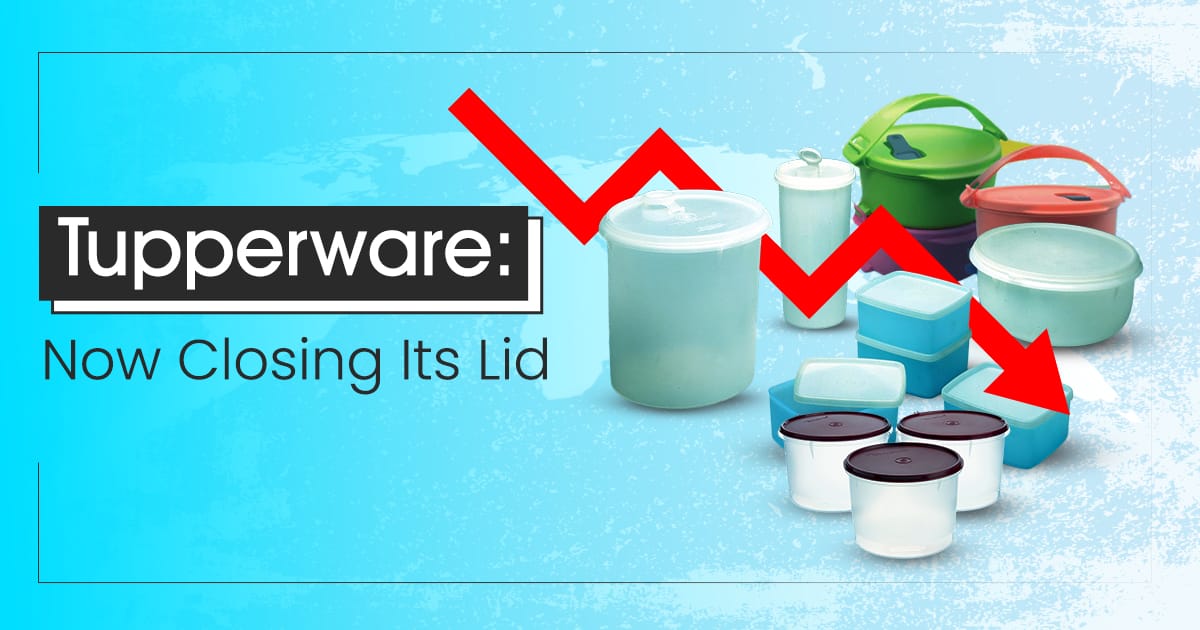Tupperware—the first thing that comes to mind for Indians is their mothers scolding them for losing the beloved “dabba.” In Indian households, Tupperware tiffin boxes were practically treated like family members. But now, it’s a tough time for the Tupperware family. While our 20-year-old tiffin boxes may still sit on the shelves, the 80-year-old company has filed for bankruptcy and will eventually stop production. So, what’s the future of our favourite tiffin boxes? Will they disappear like dinosaurs? Let’s take a closer look through the Brew Lense.
The Evolution of Tupperware and Its Revolutionary Strategy:
Tupperware was founded by Earl Silas Tupper in 1948 with the vision of transforming how people perceive plastic containers. Earl realised that high-quality plastic could preserve food for longer periods, and with the post-World War II boom in plastic production, the timing was perfect. While Earl laid the foundation, it was Brownie Wise who truly catapulted Tupperware into the mainstream with her innovative strategy. She introduced the famous “Tupperware Party,” a direct selling approach that allowed women to sell products from their homes, creating a powerful and unique business model. The company’s success was built around three key strategies known as the 3 Ps: Product, Party Plan, and People. Let’s dive into each of these:
Product:
Whether it was 100 years ago or today, Tupperware’s product philosophy has always remained steadfast: quality is non-negotiable. Tupperware offered durable, versatile containers that lasted a lifetime. In India, Tupperware was often passed down to the next generation! The brand constantly evolved its products, making them microwave-safe, fridge-friendly, and improving the overall design to meet consumer demands. Each innovation was designed to keep Tupperware relevant in an ever-changing market. Their containers became synonymous with quality, making them not just a practical choice but a trusted household name.
Party Plan:
Perhaps the most innovative strategy that Tupperware introduced was the Tupperware Party. This wasn’t just a sales tactic; it was a social phenomenon that was ahead of its time. The Party Plan was engaging, fun, and worked similarly to modern-day social media. Dealers would host gatherings in their homes, displaying Tupperware products to potential customers in a friendly, informal setting. This face-to-face interaction allowed consumers to experience the ease and functionality of Tupperware firsthand. The parties fostered personal connections, allowed for product demonstrations, and encouraged word-of-mouth marketing, which boosted sales and customer satisfaction.
People:
Tupperware was not just a company that sold products; it was a people-centric organization. The company valued its people, providing them with training, support, and resources to create a smooth shopping experience. By involving women in the business and offering them the opportunity to earn an income from home, Tupperware empowered its dealers and created a loyal network. The company recognized that its success depended on the strength of its people and, as a result, invested heavily in them.
Other Factors Behind Tupperware’s Success:
In addition to the 3 Ps, Tupperware employed several other strategies that were groundbreaking at the time and have become standard practices in today’s business world. These include:
- Women Empowerment: A large portion of Tupperware’s workforce consisted of women. This focus on gender diversity and equality opened new doors for women and strengthened Tupperware’s relationships with its customers. By involving women at all levels of the company, Tupperware fostered a culture of support and collaboration that made it a pioneer in empowering women entrepreneurs.
- Compensation Plan: Tupperware’s compensation structure was designed to motivate its team members. Dealers earned through sales commissions, and as they progressed in the company, they earned a portion of their team’s sales as well. This incentivized dealers to support their team members and encouraged a sense of camaraderie. The result was a sales force that worked together to ensure mutual success.
- Global Market Expansion: Tupperware continually expanded into new markets, targeting regions that were previously untapped. Using its direct selling model, Tupperware established local teams to sell products, create jobs, and support small businesses. This approach allowed Tupperware to build a strong presence in countries across the globe, ensuring its products reached as many consumers as possible.
- Manufacturing and Distribution: To meet local demand and reduce costs, Tupperware set up manufacturing facilities in different countries. This allowed the company to manage supplies more efficiently and tailor its products to regional preferences. Additionally, Tupperware carefully selected distributors to ensure its products were widely available, contributing to its global success.
- Acquisition Strategy: As consumer needs evolved, Tupperware used acquisitions to stay ahead of the curve. By purchasing other companies, Tupperware was able to expand its product offerings and enter new markets. These acquisitions allowed Tupperware to introduce high-end consumables that complemented its existing product line, further solidifying its position in the market.
Tupperware’s Marketing Techniques:
Tupperware has employed a range of marketing strategies to maintain its strong brand identity over the years. These include:
- Direct Selling: The party plan has remained one of Tupperware’s most effective direct selling methods. By physically showcasing and demonstrating products, dealers can create a more engaging shopping experience for consumers.
- Traditional Advertising: Tupperware also uses traditional forms of advertising, such as magazine placements, to reach a broader audience and strengthen its brand presence.
- Strategic Partnerships: By forming partnerships with other brands, Tupperware engages in cross-promotion and gains access to new markets. This has been instrumental in broadening its consumer base.
- Multi-Channel Marketing: In recent years, Tupperware has embraced social media and email marketing to connect with individual customers. This multi-channel approach ensures that Tupperware stays relevant in the digital age.
What are the key factors behind Tupperware’s bankruptcy?
Tupperware has been facing financial and sales challenges for a long time, but the situation has now reached its peak. While the brand’s legacy remains, it has struggled with these issues for over a decade. Here are the 5 main reasons:
Failure to Adapt to Digital Transformation: Tupperware struggled to adjust to the shift in consumer buying habits toward online platforms. The company continued to rely heavily on direct-selling methods through independent representatives, while many customers preferred shopping on e-commerce giants like Amazon and Walmart. This inability to fully embrace digital sales channels contributed to its declining sales.
Rising Costs and Supply Chain Issues: The company faced a significant increase in labor, freight, and raw material costs, especially for plastic resin. These rising expenses, coupled with global supply chain disruptions, further hindered Tupperware’s ability to remain competitive in the market. The pandemic exacerbated these challenges, with costs climbing as operations resumed post-COVID.
Mounting Debt: Tupperware had accumulated a massive debt of USD 812 million, much of which was purchased by distressed debt investors. The company’s financial position worsened as creditors pushed for control over its assets, including intellectual property, which forced Tupperware to seek bankruptcy protection.
Changing Consumer Preferences: As consumers became more environmentally conscious, there was a growing demand for eco-friendly products. Tupperware, known for its plastic containers, struggled to capture this segment of the market. Shoppers opted for cheaper and more sustainable alternatives, further reducing demand for Tupperware’s products.
Impact of the COVID-19 Pandemic: While Tupperware saw a temporary spike in sales during the pandemic as people turned to home cooking, the boost was short-lived. As the world returned to normal, sales plummeted again, and the company’s attempts at recovery were stifled by rising operational costs and changing consumer habits. The pandemic served as both a brief lifeline and a final blow to the company’s financial stability.
Insufficient Marketing Efforts in a Cluttered Market: Tupperware may be investing in innovation and research, but they aren’t making enough noise about it. In a competitive landscape where new players emerge daily, staying vocal about their efforts is essential. Regular marketing and showcasing new initiatives are crucial for keeping customers informed and engaged.
Tupperware in India: The Emotional Bond:
Though Tupperware originated in the U.S., it has developed a deep, emotional connection with Indian consumers. Over time, Tupperware containers have become affectionately known as “tiffin dabba,” a term that holds cultural significance in India. Despite the brand’s challenges, including its recent Chapter 11 bankruptcy filing on September 17, 2023, India continues to embrace Tupperware. The company’s iconic plastic dabbas and colorful kitchenware have made a lasting impression on Indian households, and the brand’s legacy seems likely to endure.
Even amid financial struggles, India remains a key market for Tupperware. Distributors have reported a significant increase in sales during the festive season, indicating that the Tupperware community in India remains strong. Tupperware’s latest financial reports show a current revenue (TTM) of ₹95.72 B, a decline from ₹107.83 B in 2022 and ₹119.40 B in 2021. Despite this drop, Tupperware continues to innovate, adding steel and glass products to its range to meet the evolving needs of Indian consumers.
After nearly 28 years in India, Tupperware has established itself as a household name. The love for its products, especially the beloved dabba, ensures that Tupperware is not going anywhere anytime soon in India.
What Are the Next Steps for Tupperware to Regain Its Appeal?
This isn’t the end, and it shouldn’t be. As a 360-degree marketing agency, it’s our responsibility to analyse the situation and propose effective solutions! We believe that a brand’s survival in today’s market relies heavily on market surveys, research, and digital marketing. Following the pandemic, our reliance on digital platforms has surged, and consumers now prioritise convenience. If a brand fails to meet these needs, it risks fading away. Here are five key steps Tupperware should take for a successful revival:
- Boost E-Commerce and Digital Marketing: Strengthen online presence with a user-friendly website and active social media engagement to reach a broader audience and facilitate easy purchases.
- Revitalize the Party Plan Model: Evolve the traditional party plan by incorporating hybrid events, allowing both in-person and virtual gatherings to attract a younger demographic.
- Expand Sustainable Product Lines: Introduce eco-friendly containers to meet consumer demand for sustainability, enhancing the brand’s identity as a responsible company.
- Leverage Influencer Partnerships: Collaborate with lifestyle influencers to showcase products authentically, driving interest and expanding reach.
- Enhance Customer Engagement with Loyalty Programs: Implement a loyalty program to reward repeat purchases and referrals, fostering community and increasing costume.
- Connect with the Next Generation of Buyers: Tupperware needs to tap into the priorities of millennials and Gen Z, such as their active presence on social media, quick decision-making, love for aesthetics, and focus on sustainability. If Tupperware fails to align with these preferences, it may struggle to maintain demand over time.
Whether it’s Tupperware or any big brand, not evolving can wipe you off the map faster than you can say “dabba!” So, what’s the plan? Join us for a stimulating discussion over a hot brew, where we’ll explore intriguing insights and analyses to develop a strategy that revitalises your brand identity and generates revenue! Connect with us before the marketing brew gets cold!





